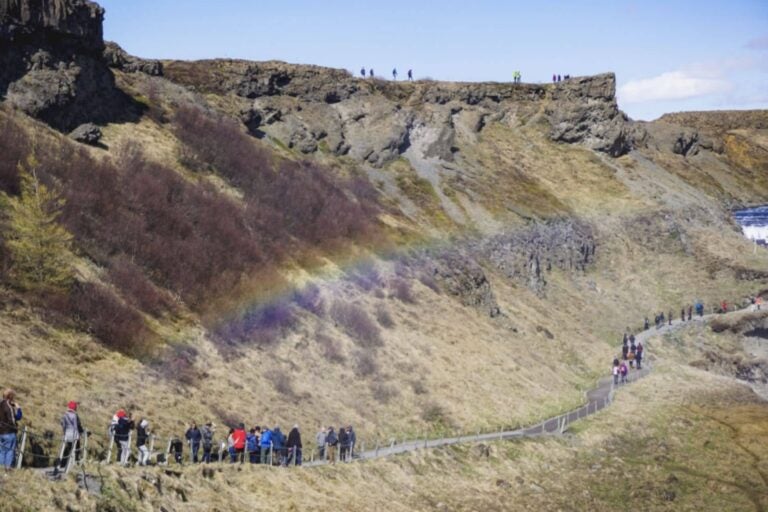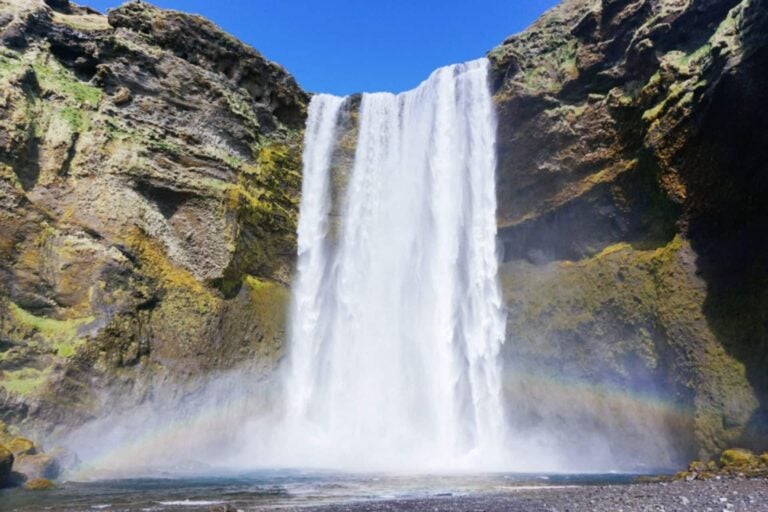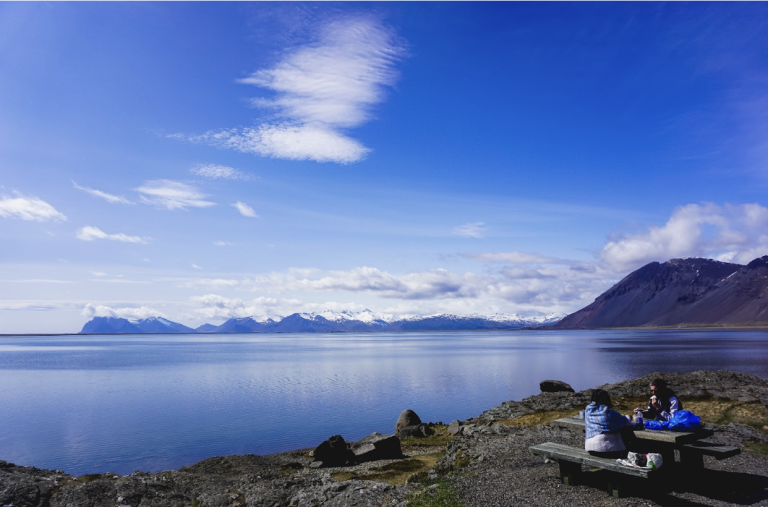The ultimate Iceland packing list for all seasons
Meet Liv, a keen travel writer, adventurer, and frequent flyer to Iceland! Here Liv walks you through her first-hand experience on everything you absolutely must pack when traveling to this beautiful country.
The last time I visited Iceland, all my preparation time was filled with itinerary planning, so my packing list took second place. Having learned from my mistakes, I’ve put together the ultimate Iceland packing list for your upcoming trip.
Before we get started, remember the basics! Passports, tickets, credit cards, your driving license, are all easy to forget amid the chaos of packing for an exciting trip to Iceland.
Visiting Iceland means planning to fit in as many activities as you can.
To make the most of each of them, you’ll need proper gear. From trekking poles to thermal underwear, here’s my seasonal packing list for Iceland. Don’t forget a reliable internet connection – it makes all the difference. You can opt for a local Iceland SIM card, or even better, an unlimited data travel eSIM.
Iceland travel checklist
You can download your free printable packing list below.
What to consider before packing for Iceland
From the annual midnight sun to the natural hot springs (and obviously the Northern lights), exploring Iceland is a magical experience.
When you think of the country, you might think of snow-carpeted landscapes, its Viking history, the Blue Lagoon, and glacial lakes — but its reality is even more extraordinary.

The name Iceland might give you an idea of the kind of weather to expect when you visit Iceland, but actually to pack for Iceland means packing for all sorts of weather conditions.
Before I get into our season-specific recommendations, here are some general tips to prepare for your journey.
Planning an upcoming trip? Check out our Iceland travel guide, covering everything you need to know.
The length of your trip
Your packing list will depend on the length of your trip, and the activities you choose to do while you’re there.
If you’re going for a city break to Reykjavíc and you’re there for a couple of days, you may not need your hiking boots.
For longer trips with camping stints, you’ll want to work out when you’ll have access to a washer and dryer, and make sure to pack enough of the essentials.
The season you are traveling to Iceland
In Iceland, each season has something special about it, meaning there are endless must-sees throughout the year.
In summer, you might visit for whale watching or the midnight sun, while winter offers the Northern lights and glacier hiking.
Spring and autumn are softer months, when the landscape gradually changes and bursts into color. If you’re wondering when to travel to Iceland, check out our guide to the best times of year to visit.
Essential items for your trip to Iceland
Let’s kick off your Iceland packing list with a few Iceland trip essentials that you’ll want with you — whatever the season!
When I last visited Iceland, I noted down these seven essentials for any, year-round trip to Iceland.
Sturdy footwear
Sturdy shoes are a must. Many of the activities you’ll do in Iceland are outside, one day you’ll take on a glacier hike and the next a trip to see wild Icelandic horses.
Waterproof shoes are recommended. It’s also worth bringing along some light shoes for the evenings, or moving around your accommodation.
Travel documents
While these are mostly digital nowadays, remember to have your transport, accommodation and travel insurance confirmation emails to hand.
You never know when you might have to find them in a rush — and especially if you don’t have internet!
First aid kit
Accessing medical care during a trip to Iceland shouldn’t be difficult, but should you find yourself a considerable distance from the nearest medical facility (e.g. while on a remote hiking trail) it’s advisable to carry an appropriate first aid kit.
Whether it’s a small cut or anti-altitude sickness pills, it’s always good to have, just in case.
Travel adaptors and chargers
For every holiday, you’ll need your travel adaptors and chargers. From camera phones to Google Maps, you never know when you’ll need to rely on your phone, so a portable charger is advisable.
If you’re bringing any camera gear, remember the chargers, second battery packs, and durable protective cases!
Knowing you can ring or help when you need is vital to enjoying your holiday — you can stay ahead of the game by buying your eSIM for Iceland and charging up your portable chargers beforehand!
Reusable water bottle
In Iceland, “kranavatn” or drinkable tap water is free and abundant — available from any tap. You can refill your bottle anywhere and ask for tap water in any restaurant or hotel.
Daypack
I’d recommend bringing a rucksack or small backpack for your daily essentials (e.g. camera, wallet, medications, extra clothing layers, bottle of water) as you may not always be able to reach your suitcase during the day — it’s also a must for any outdoor adventures including hiking excursions or picnics.
If you can bring it onto your flight as a carry on bag, it’s about the right size.
Snacks and energy bars
While you can buy these in Iceland, it never hurts to bring some emergency snacks, like dried fruit, oat bars, or nuts.
It’s good to have a sugar rush on hand to get you through a long hike — or just a long plane journey!
Iceland packing list for summer
An Iceland summer packing list requires plenty of light layers, with warmer average temperatures from May to September.
Average summer temperatures in Iceland:
- June: 54°F / 46°F
- July: 57°F / 49°F
- August: 55°F / 47°F
I visited in summer and found it difficult to sleep in the light of the midnight sun, so an eye mask and sunglasses will be helpful.
There aren’t many insects in Iceland, but small midges do thrive in the summertime, particularly by lakes and streams.
It’s worth bringing some insect repellent or fly masks, particularly if you’re horse riding, or spending time near Lake Mývatn.

Lightweight clothing
In summer, you’ll want lightweight hiking trousers — some even opt for trousers that unzip at the knee for a shorts alternative.
Even if it’s warm, I’d also advise bringing a thin jacket to keep out the wind chill on those early morning starts.
Rain jacket and clothing
Rain pants and a waterproof jacket are must-haves for the hiking trails you’re likely to visit. The weather can turn quickly, and (even in the warmer months), rain showers are unpredictable — and it’s never nice to get wet.
Swimwear
If you’re feeling brave, you might take a cold plunge in an icy fjord. In addition to bathing suits, remember to bring good grip flip flops for getting in and out of the water as it can be rocky.
In the summer months, you might opt for scuba diving and snorkeling with puffins, auks, and humpback whales in Akureyri and Grimsey Island, or visit the wild swimming pools in Silfra.
They’re all incredible activities, but they require planning ahead to bring the right gear — so you can get the most out of your experience!
Sunscreen
While you should bring SPF products with you all year round, a summer trip demands plenty of sunblock as you’ll likely be spending most of your time in the great outdoors (and 24/7 sunshine at certain times).
Hiking shoes
Waterproof hiking boots are advisable for all times of year. Remember to break in your boots before you set off on a long hike — and bring plenty of blister plasters if walking is your main activity.
It’s better to be safe than sorry!
Iceland packing list for fall
Fall in Iceland is chilly, with temperatures ranging from 36°F to 45°F. To stay cozy in the crisp weather, be sure to pack warm layers and appropriate outdoor clothing.
Average fall temperatures
- September: 50°F / 42°F
- October: 44°F / 36°F
- November: 39°F / 30°F
Warm jacket
During my trip, I found that a lightweight down jacket to go under a heavier outer coat is a great hack for keeping warm and protected whatever the weather.
Most down jackets can also be packed away into very small spaces, making them ideal for those who want to pack light.
Cold-weather accessories
Cold-weather accessories include lip balm (I’d recommend using a lip balm that contains SPF, as Iceland’s high latitude doesn’t rule out the risk of sunburn), a warm hat (you’ll see tourists wearing these even in the hot springs!), and hand warmers, which we’ll get to.
Waterproof outerwear
October is one of Iceland’s rainiest months, averaging at a day of rain every two days.
You’ll need to stock up with a waterproof jacket and waterproof pants, and consider a rain cover for your waterproof hiking boots.
Layered clothing
T-shirts, vests, long-sleeved shirts, you name it, you’ll want it. To stay warm in Iceland you’ll need to trap as much heat as you can for as long as you can.
Closed-toe shoes
When deciding what to wear in Iceland in autumn, prioritize closed-toe shoes. Losing a toe to frostbite is not the kind of holiday souvenir you’re looking for!
Iceland packing list for winter
Iceland’s coldest season is dark and snowy. Prepare for freezing temperatures by packing the proper winter gear.
Average winter temperatures:
- December: 36°F / 29°F
- January: 36°F / 28°F
- February: 36°F / 28°F
Insulated clothing
When packing your insulated clothing, a proper winter hat is essential — ideally something with a couple of insulating layers.
A down jacket for winter is also recommended for their great ability to retain heat. Socks, gloves, thermals, make sure you bring enough for at least two clothes changes in case you get wet.
A long-sleeve base layer is also very effective in keeping out the cold.
Heavy coat
In addition to a waterproof coat, you’ll need a coat that is heavily insulated. You can rent proper winter coats in Iceland, but it’s worth making an investment if you think you’ll be back.
Insulated boots
A good pair of winter boots and snow pants are essential — trust me, there’s nothing worse than being cold and wet. In many places in Iceland you can rent snow boots, but remember to pack several pairs of heavy wool socks to keep your toes warm.
Hand warmers
Freezing cold fingers is never a good feeling, and sometimes (if you’re like me) a thick pair of gloves just won’t cut it. Add some hand warmers to your pile of warm clothes — you won’t regret it.

Iceland packing list for spring
In spring, the days get longer, the snow thaws slowly, and nature comes back to life. Summer is still far away — don’t be fooled by the sunnier weather.
Although it gets warmer starting in March, you should expect temperatures between 32°F and 41°F.
Average spring temperatures:
- March: 38°F / 30°F
- April: 43°F / 34°F
- May: 48°F / 40°F
Light to mid-weight clothing
Spring temperatures can vary, so bring lots of light to mid-weight clothing, rather than the heavier gear you’ll need for winter. You can layer up and layer down depending on the weather conditions.
Rain gear
After October, March is Iceland’s second rainiest month, meaning you’ll need to ensure your waterproof hiking shoes are packed!
I also found my water resistant phone case to be a game-changer during bouts of rain. It meant I could rest easy on boat trips or while walking round the fjords.
Hiking boots
The key to dressing well for hiking in cold weather is layers, layers, and more layers. Glacier hiking is popular in Iceland, and you’ll want to come prepared.
Bring plenty of long-sleeved shirts, and thermal leggings for underneath your hiking trousers (thermal underwear is also recommended!). If you feel hot, you can just peel off a layer.
5 essential Iceland packing list tips
Now that I’ve walked you through my top essential items for each season, we’re down to my last (and most valuable) top tips for what to pack for Iceland.
More general this time, it’s worth noting down these five pointers before setting off on your Icelandic trip.
Putting together your travel itinerary? Here are the ten best places to visit in Iceland.
1. Pack light
It might sound like a lot to bring, but — as long as you wear your big jacket and boots on the flight — it is possible to pack light.
For shorter trips, I’d advise keeping it in a carry-on bag and hand luggage, as it makes it much easier to get around once you’re in Iceland.
2. Use eco-friendly products and minimize waste
Travel zero waste in Iceland to maximize the quality of your experience. Iceland is a self-reliant country and prioritizes zero-waste best practices to things like food and plastic.
Here are some ideas for traveling as close to zero-waste as possible:
- Pen
- Spork
- Bar soap
- Cloth napkin
- Handkerchief
- Steel pint glass
- Reusable straw
- Sealable food container
- Reusable, thermal water bottle
3. Have access to Icelandic local currency
The official currency of Iceland is the Krona. As of July 2024, the exchange rate was 137.75 ISK to $1 USD. While this might be favorable, remember that Iceland is not a cheap country.
It’s also worth remembering that Icelandic krona notes only come in denominations of 500 or higher. US banks won’t exchange coins, so try to spend those before coming home.
4. Keep essential numbers handy
You might have planned out your trip to the minute — or you might favor a more spontaneous approach.
Either way, it’s useful to have a couple of numbers to hand, whether that’s a taxi service you’ve found or a hotel where you’re planning to spend your first night.
You might also keep the Search and Rescue (570-5900) and Reykjavik Police Station (444-1000) numbers handy.
5. Consider an eSIM for flexible internet access
Holafly’s affordable Iceland eSIM includes fast, reliable internet and unlimited data — as well as 24/7 customer service.
The best bit is, you don’t even need extra space to pack it! It couldn’t be more convenient.
With Holafly, you can rest easy knowing that you (a) are ultra-prepared for your trip and (b) will be able to make the calls and use the data you need to.
To see how it compares, take a look at the top four eSIMs for Iceland.
If your journey extends beyond Iceland, the eSIM for Scandinavia keeps you connected across Iceland, Denmark, Finland, Norway, and Sweden with seamless coverage, no SIM swapping needed.
Need cellular internet on your next trip?
Use the code MYESIMNOW5 and get a Holafly travel eSIM with a 5% discount.
Zipping up your Iceland packing list
Now that we’ve covered what to pack for Iceland, you’re ready for your trip — and all the weather conditions it might bring with it!
From waterproof pants to sunblock and an eSIM, packing for Iceland is all about practicality, and less about the aesthetics.
Staying warm and dry is a top priority, because who can enjoy the natural wonders when cold and wet? Your other priority? Sending pictures to the family Whatsapp group. Stay connected with Holafly. Þetta Reddast!





 Language
Language 


















 No results found
No results found





